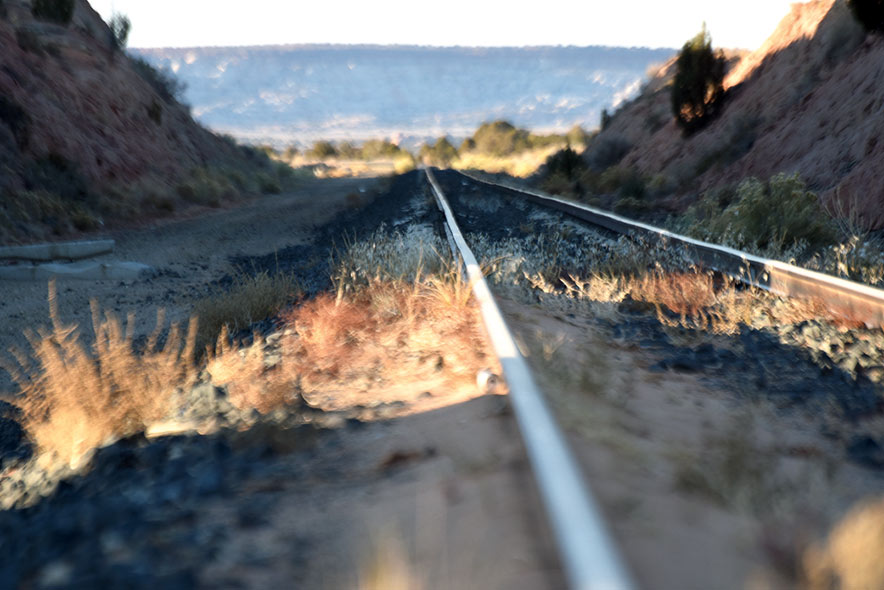
Guest Column | Navajo, U.S. officials must defend restoration of Black Mesa before it’s too late
By Nicole Horseherder
Years ago on Black Mesa, our livestock drank from springs and seeps across the plateau.
Water appeared in the mornings and our animals grazed the native grasses that had sustained them for generations.
Today, my family still lives and works on Black Mesa, raising sheep and horses, but the seeps and springs have all dried up. Today we haul water from community wells.

Navajo Times | Krista Allen
Shrubland is visible as the closed Black Mesa-Lake Powell Railroad corridor is undergoing ecological succession. The 78-mile railroad was constructed by Morrison-Knudsen Company Inc. in the early 1970s. It was completed in 1973.
It’s dangerous, costly and time consuming to haul all your water needs from 30 miles away.
For those of us who live on Black Mesa, the damage done by the more than four decades that Peabody operated its Black Mesa and Kayenta mines is clear from the scarcity of natural springs and grasses that were once plentiful.
Unfortunately, in the years since Black Mesa mine closed in 2005, and Kayenta mine in 2019, efforts that are supposed to return this damaged land to its pre-mining condition have been far from successful.
And the window to fix that is closing. Peabody has submitted applications for Black Mesa mine that would permanently release the company from reclamation liability on nearly 3,000 acres of land.
But what I saw during a mine site visit last fall shows that Peabody’s reclamation is far from complete and wholly inappropriate for the arid Southwest.
Peabody and officials from the federal Office of Surface Mining, Reclamation and Enforcement have disregarded the traditional ecological knowledge that is crucial to achieve any level of success in the eyes of our local community. Without consulting any of the people who live on Black Mesa, the company has planted non-native grasses with no regard for how these invasive species will affect our land or grazing livestock.
Beyond that, Peabody has not made public any plans to address the damage it has caused to seeps and springs where mining has destroyed surface geology or depletion of the pristine Navajo Aquifer, the only source of drinking water for the more than 50,000 people on Black Mesa.
Before the OSMRE approves Peabody’s request, it must require the company to involve the Bureau of Indian Affairs, the Navajo Nation, the Hopi, and the local community in the development of a long-term land stewardship plan.
This plan must address concerns such as erosion, weed control, stormwater channel repairs, revegetation, grazing and other land-use restrictions. These discussions should form the basis for post-reclamation financial assurance, as is consistent with Bureau of Land Management practice.
Releasing Peabody before these requirements are met sets a terrible precedent for the reclamation still needed of Kayenta and other mines on native lands.
To ensure these requirements are met, our Navajo Nation leadership needs to be more proactive and involved. To date, a resolution asking for a significant permit revision and a letter to OSMRE on these issues have been ignored by both the Navajo Nation Council and the president. Whether the Navajo Minerals Department and Division of Natural Resources can accurately convey the problems and issues to OSMRE and provide solutions remains to be seen.
One of the problems with OSMRE’s oversight is that neither it nor mine operator Peabody have provided residents with access to documentation that is critical to understanding what is happening with reclamation so that we can make informed decisions and provide input.
We need full access to OSMRE’s reports on Peabody’s activities on Black Mesa, an up-to-date OSMRE website on the Black Mesa/Kayenta Mine reclamation initiative (which was last updated in 2014), and public meetings to explain the bond-release process and allow for public questioning and input.
And we need this before the window of opportunity closes and Peabody is granted a final release of reclamation liability.
The Navajo Nation government also shares some of the blame. Rather than listening to the expertise of the people who live on the land about what is appropriate, the tribe’s mining officials – who admit they are still learning as they go – largely just defer to bureaucratic decisions made by OSMRE.
Ultimately, this results in reclamation standards that are wrong for the ecosystem and climate of Black Mesa. And it is all excused by mining laws and reclamation plans that are deficient in the first place.
It shouldn’t take community groups to raise these issues. The Navajo Nation has both the authority and responsibility to monitor and make sure reclamation gets done right. As of now, it is not meeting this responsibility.
I hope future generations of our people will be able to prosper on Black Mesa, but that will require a fair, transparent process that involves those who live on and are affected most by this mine reclamation effort.
It will require a long-term plan from Peabody that addresses how our land and water will be maintained well into the future. And that plan must take into account the unique needs and knowledge of our people.
We cannot allow this window to close and we cannot allow Peabody to conduct its work behind closed doors. After more than half a century of the company scarring our land and destroying the underground geology that created vital surface water resources, we deserve more.
Reclamation of the land and water is the foundation to economic development and long-term prosperity on Black Mesa.
Nicole Horseherder is the executive director of Tó Nizhóní Ání and a lifelong resident of Black Mesa.








 Highway 264,
Highway 264, I-40, WB @ Winslow
I-40, WB @ Winslow